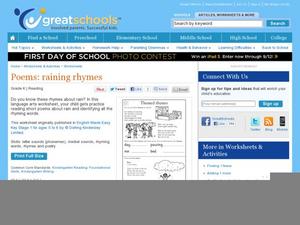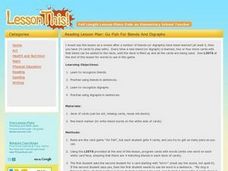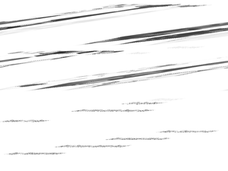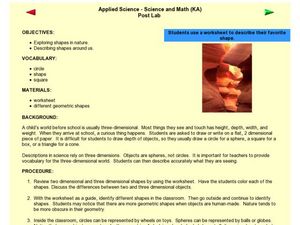Curated OER
Themed Rhymes
Familiar sing-along rhymes about rain help scholars with phonemic awareness. They read the poems and write rhymes for four words. The clue here? Each of the words is out of one of the sing-along rhymes! Learners read a final poem about...
Curated OER
Dinosaur Tracks and Critical Thinking
Get your young scientists excited about geology through the study of dinosaur tracks! They will use their power of observation to learn how tracks are made and use critical thinking strategies to suggest a scenario in which they were...
Curated OER
Our Natural Resources
Your class will learn about natural resources and man-made items and differentiate between them. They chart resources from seven pictures and explain how each natural resource is used.
Curated OER
Go Fish For Blends and Digraphs
Youngsters practice using blends and digraphs. In this early reading lesson, students play a game of "Go Fish" using words that contain a blend or digraph. This allows them to practice recognizing the word and using it in a sentence.
La Jolla High School
Of Mice and Men by John Steinbeck: In Search of Figurative Language
While this resource was originally made to be used in conjunction with John Steinbeck's Of Mice and Men, it could be used for any literary text. A reference sheet for readers, the resource includes terminology related to figurative...
Curated OER
Chasing Metaphors
Students use metaphors in order to see commonly experienced objects, events, and people in new and more meaningful ways.
Curated OER
Drip... Drop... Raindrops
Students demonstrate the steps of evaporation, cloud formation, and precipitation within the water cycle. They make and demonstrate how to use a hygrometer to record daily humidity and describe how rain, snow, and sleet form.
Curated OER
Pen and Ink Drawing
Learners hone their drawing techniques to create a nature-inspired piece of art. They practice hatching, cross hatching, stippling, and shading. They discuss how each method is better suited for creating specific elements in nature such...
Curated OER
Sea Turtle Crossword
In this completing a crossword puzzle about sea turtles activity, students read clues across and down and use the words in the word bank to solve the puzzle. Students write 9 answers.
Curated OER
The Nine Parts of Speech
Use this helpful resource to review the parts of speech. This is a motivating and interesting way to discuss nouns, adjectives, pronouns, verbs, adverbs, prepositions, conjunctions, articles, and interjections. This could be used in a...
Curated OER
Listening Comprehension: Retell Main Events of a Story
Story retell is a very important skill. Little learners use a story map and a previously heard story to walk through the retell and story sequencing process. They complete this activity as a whole class and then on their own.
Curated OER
Introduce Vocabulary: From Tadpole to Frog (Pfeffer)
Take an amphibious journey with budding readers as you explore vocabulary in Wendy Pfeffer's informative book From Tadpole to Frog. This text is the backdrop of a vocabulary exercise based on six words: fertilize,...
US Environmental Protection Agency
Non-Point Source Pollution
Investigate the different types of pollution that storm drain runoff carries into oceans, lakes, rivers, and streams with this class demonstration. Using an aquarium and an assortment of everyday items that contaminants like motor oil,...
Shodor Education Foundation
Rabbits and Wolves
A change in a parameter can end in overpopulation. The resources gives pupils the opportunity to control the parameters of rabbits and wolves in a natural setting. Using the set parameters, the simulation runs and displays the population...
Curated OER
Peter Max Style Ties
Here is a rare example of an art lesson which can be used K - 12. Learners view prints of Pop artists. They discuss Pop artists such as Andy Warhol, and Peter Max. They cut tie shapes out of oak tag, and design ties in Pop art style....
Curated OER
Sustainability and the Recycling of Words
Recycling and green living isn't just for the environment anymore. Studying the use of metaphors and metonymies, especially in reference to environmental sustainability, this presentation provides viewers with plenty of food for thought....
Curated OER
An Interdisciplinary Approach to Learning with Walt Whitman
Use poetry as a mode for creating interest and cross discipline learning.
Curated OER
A Mysterious Story Poem
Your scholars will be hooked after reading the cryptic narrative poem "The Listeners." They explain why it is so mysterious, then use the poem to learn about pronouns. Learners read an excerpt from the poem that has been altered to...
Reed Novel Studies
Freckle Juice: Novel Study
Is the grass always greener on the other side? Andrew from Freckle Juice seems to think so! He admires his classmate's freckles and wishes he had some of his own, so he purchases a special juice to get them! While reading through the...
Reed Novel Studies
Lawn Boy: Novel Study
A mountain of grass becomes a mountain of cash in the case of a young entrepreneur in the novel Lawn Boy. Arnold, a main character, begins a lawn mowing business and meets a stockbroker client that helps me manage his money....
Reed Novel Studies
Runaway Ralph: Novel Study
Maybe the grass isn't always greener on the other side. Ralph, a mouse character in Runaway Ralph, thought that summer camp had to be better than dealing with his mother, uncle, and cousins. However, camp has its troubles, too. Worksheet...
Curated OER
Habitats: Cactus Hotel
A reading of Brenda Z. Guiberson’s, Cactus Hotel, launches a study of animal habitats. Working with parent volunteers or teacher aides, groups travel outside the classroom to select a habitat, take digital pictures, and incorporate the...
Curated OER
Interactions of Living Things
Is it a producer, carnivore, omnivore, scavenger, or decomposer? Different relationships among organisms are explored here. It is a simple, multiple choice assignment. Use it as a quick warm-up or quiz.
Curated OER
Applied Science: Exploring Shapes in Nature
Explore geometry with your young mathematicians! First, have them color in different two-dimensional and three-dimensional shapes. Then take them on a walk around the classroom. Can they identify different shapes using the target...





















